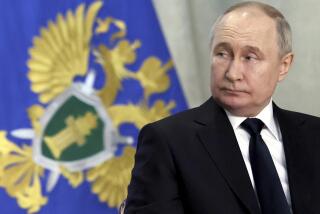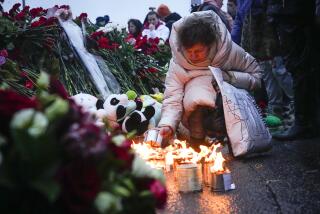Television Yeltsin’s Avenue to the People
- Share via
Waiting. . . .
Waiting, via television, as we did two years ago on violence to flatten the democratic spirit of Tian An Men Square, and as we did in January on allied bombs to officially start the Persian Gulf War, and then on Scuds to fall on Israel and Saudi Arabia.
And now waiting again.
This time for Soviet tanks to move Tuesday on the Moscow government building known as the “White House,” where embattled Russian President Boris N. Yeltsin and many of his supporters had armed and barricaded themselves in anticipation of an attack from leaders of the coup that plucked Mikhail S. Gorbachev from power.
“The mood here is very tense,” Cable News Network producer-reporter Claire Shipman told viewers as well as her husband, Moscow bureau chief Steve Hurst, who had a clear view of the building from his own rooftop post at a nearby high-rise where CNN maintains offices.
Yet Shipman, who had just returned with Hurst from their honeymoon, was speaking from within the “White House,” one of a handful of broadcast reporters who spent some of Tuesday describing to outsiders what was happening inside this makeshift fortress housing the Soviet Union’s hopes for democracy.
One of the reporters, ABC’s just-arrived Diane Sawyer, spent only a couple of early morning hours in the building, just long enough to scoop everyone by taping an interview with Yeltsin for Tuesday’s “World News Tonight” and possibly “Nightline,” whose anchor, Ted Koppel, was himself en route to Moscow.
But it was elsewhere, initially on CBS, that a drama was dribbling out that appeared to capture the taut essence of Yeltsin’s struggle for survival against overwhelming military odds on an evening in which the city had been put under curfew.
And the human conduit this time was no celebrity journalist, but Artyom Borovik, a relatively obscure Soviet magazine editor who had been helping with a “60 Minutes” segment on the coup scheduled to air Sunday.
On Tuesday, Borovik logged at least 60 minutes of his own in speaking by phone from the “White House” to CBS anchorman Dan Rather in New York at a time when darkness had fallen in Moscow and the other networks were droning on with regular daytime fare.
When Borovik first came on, it was 10:40 a.m. (PDT), after Hurst and NBC’s Ike Seamons had reported from Moscow that Yeltsin’s group felt an attack was imminent, after NBC anchorman Tom Brokaw had announced that a column of about 100 Soviet tanks was a mile from the government building, after NBC’s Fred Francis had reported ominously from the Pentagon that the approaching force was “mostly Asian troops” who could be expected to obey orders to fire upon Muscovites.
Speaking excellent English, Borovik said Yeltsin’s people had obtained information about military movements by intercepting “tank dialogues.” He said the attackers were expected to strike at night when they could use darkness to shield their actions from TV. He said the government building had been mined but that its fortifications “would not be a serious problem for professional soldiers to get inside.’
“Are you armed at this moment?” Rather asked. “Well . . . most of us are,” Borovik replied.
Rather’s mouth seemed to tighten even more than usual.
Borovik said Yeltsin remained in the building. Former Foreign Minister Eduard A. Shevardnadze--who had forecast dictatorship on the Soviet horizon--was there, too, Borovik said.
At one point, Rather asked Borovik if he could get Yeltsin himself to the phone, or Shevardnadze. Take that, Diane Sawyer! But later Borovik returned to the phone alone, bearing a statement from Yeltsin.
Yeltsin wanted coup participants to know they would not be punished if they began obeying Soviet and Russian laws. It seemed that Yeltsin, in the best traditions of politicians, was using American TV to reach the public.
Outside the “White House,” meanwhile, CBS correspondent Bert Quint reported seeing women linking arms while carrying a banner: “Soldiers, don’t shoot Soviet mothers.”
A little later, CNN’s Shipman reported that many inside the government were optimistic. “They say they are ready for whatever happens.”
Several hours later, something was happening, as Borovik reported hearing Kalashnikovs firing.
Then CNN’s Hurst reported hearing sporadic gunfire. Then he reported an “ominous calm.” Then sounds of automatic gunfire merged with his Hurst’s voice, now excited: “Somethin’s happening. We better get hot!”
Instead, CNN went to a commercial, returning with dramatic amateur footage of perhaps a dozen people watching a Soviet tank burn in the night.
Would the big attack come? That was the nagging worry throughout these hours of blackness that Hurst correctly called “a gloomy night, a rainy night, a night full of tension.”
The Big 3 networks’ Soviet crisis is getting a C-minus from news watchers. In Calendar.
More to Read
The biggest entertainment stories
Get our big stories about Hollywood, film, television, music, arts, culture and more right in your inbox as soon as they publish.
You may occasionally receive promotional content from the Los Angeles Times.










